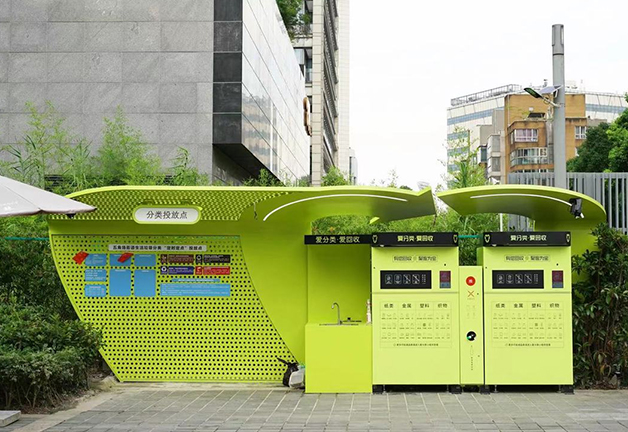EDUCATION CHAPTER









Municipal Solid Waste (MSW) is the major waste disposed of at landfills. According to the latest statistics in Monitoring of Solid Waste in Hong Kong 2023 by the Environmental Protection Department (EPD), the average daily quantity of solid waste disposed of at landfills in 2023 was 15,783 tonnes, of which, 10,884 tonnes (70%) were MSW.


School waste is classified as domestic waste under the category of MSW.
According to the EPD's latest statistics, the five major types of MSW in 2023 are as follows:

Hong Kong's MSW is mostly disposed of at landfills, which consist of three strategic landfills: North East New Territories Landfill (NENT) in Ta Kwu Ling, West New Territories Landfill (WENT) in Tuen Mun and South East New Territories Landfill (SENT) in Tseung Kwan O.
The SENT landfill receives only construction waste from 6 January 2016 in response to TKO residents' concerns about odour and traffic. This reduces the number of landfills for MSW to two.
The biggest flaw with landfills is that they take up valuable land resource. The three strategic landfills occupy a total area of 305 hectares, comparable to the size of 320-hectare Kai Tak Development zone. Even landfills are full and closed, they continue to produce gases and leachate. It takes at least 30 years to fully restore them, and they are available for very limited use such as recreation and landscaping grounds, due to settlement problems, regarding to the 13 closed landfills.
Nobody welcomes landfills in their backyards due to the unavoidable problems of odour, gases and leachate during operation, even though they are designed as a secure containment facility with impermeable liner, leachate collection and gas extraction.
The three landfills are expected to reach capacity between 2026 and 2030. Extension plans or new landfills are not long-term solutions and are likely to face local opposition. Hence, a sustainable waste management plan with proactive participation of the public to reduce waste at source is much needed.

The NENT landfill in Ta Kwu Ling is located close to Liantang in Shenzhen. Its extension has brought it closer to Shenzhen residents, whose numbers have grown exponentially due to economic development. This inescapable odour problem is causing disturbance to Shenzhen residents, prompting the Hong Kong government to take actions to reduce MSW disposal at the NENT landfill.
The Waste Blueprint for Hong Kong 2035 envisions a Zero Landfill future. The Integrated Waste Management Facilities (IWMF) - I ‧ Parks - are under construction, which marks the transition of waste treatment from landfills to incineration.
Incineration can reduce the volume of waste by up to 90% and minimizes the demand for land significantly. The IWMF will recover heat energy from incineration process to generate electricity, thereby reducing the use of fossil fuels and addressing the underutilisation of resources.

Vision of Zero Landfill is hard to attain. Assuming all MSW are incinerable, the non-combustible residue of combustion, i.e. bottom ash, would still remain. Although bottom ash is reusable as construction materials, some portion may still require landfill disposal.
Since not all waste is suitable for incineration, the concept of "Zero Landfill" is a commendable ambition of breaking free from the traditional practice, not to be taken literally.

Incineration produces highly toxic dioxin byproducts that can cause cancer, reproductive and developmental problems etc. Dioxins form easily at a temperature between 500°C and 600°C, the common temperature range for older models of incinerators, during incineration. Advanced incinerators adopt the 3T technology, namely High Temperature, Residence Time and High Turbulence to ensure complete combustion of wastes, thus substantially reduce dioxin formations.

The MSW recovery rates hovered at 30% over the past decade and dipped in the pandemic year of 2020. It gradually climbed up to 33% in 2023 (1.97 million tonnes). Hong Kong has a long way to go before reaching medium-term target of 55% recovery rate set in the Waste Blueprint for Hong Kong 2035.
The majority of recyclables were metals and paper which amounted to over 80% of 1.97 million tonnes of MSW recovered in 2023.

*Others: textiles, wood, yard waste, rubber tyres, rechargeable batteries and fluorescent lamps/tubes.
Public awareness of recycling goes no further than putting recyclables into recycling bins. But this is only the beginning of resource recovery, aiming to reuse the resources in a circular manner.

Rinse recyclables (plastic bottle, aluminium cans, beverage cartons etc.) and dry them to maintain environmental hygiene before recycling. Clean bins encourage recycling.
Clean recyclables save recyclers’ time and work, which means a lower operational cost and increased profit margin.
Clean recycling includes removing non-recyclables as well, in particular, things like staples from paper, plastic tapes from Styrofoam packaging and pistons from plastic bottles, which may cause machinery breakdowns during treatment process.
For years, Hong Kong's recyclers collected recyclables and exported them to mainland China or countries in Southeast Asia, with minimal processing occurring locally. This made the recycling industry vulnerable to external factors.
When China enacted a waste import ban in 2018, recycled materials that did not comply with the updated regulations were rejected and piled up at Hong Kong's docks with no place to go for some time.
This crisis marked a turning point for recyclers to break with their "bale and export" practice, and encourage development of new technology and business models. The percentage of recyclables recovered locally increased gradually since 2018 from less than 10% to 20%.
Hong Kong's recycling facilities developed from roadside three-colour bins to an extensive network involving a myriad of public and private stakeholders. Recycling has become part of everyday life for the public.
Recyclable items grew with recycling facilities from three to include regulated electrical equipment (REE), small electrical appliances, fluorescent lamps and tubes, rechargeable batteries, glass bottles, beverage cartons etc.
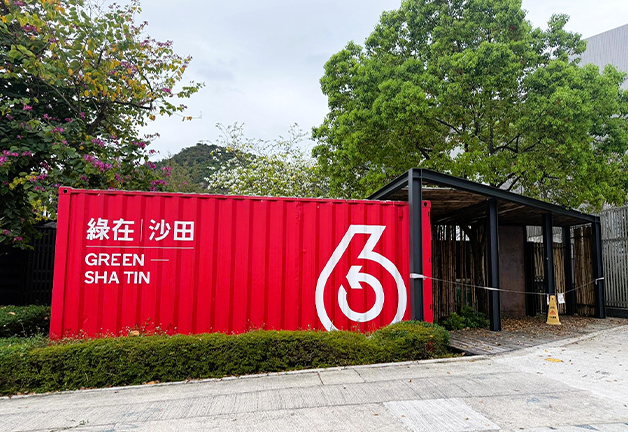
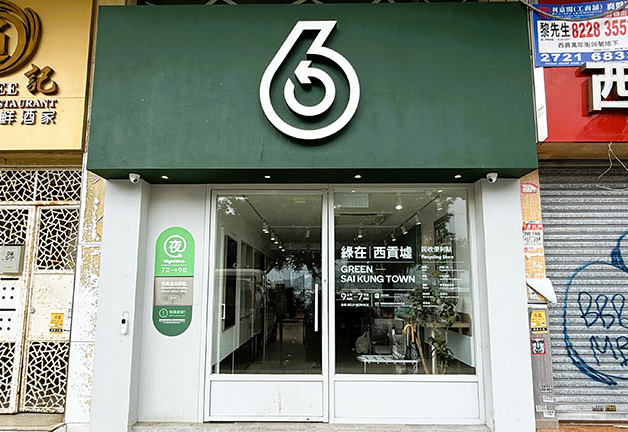
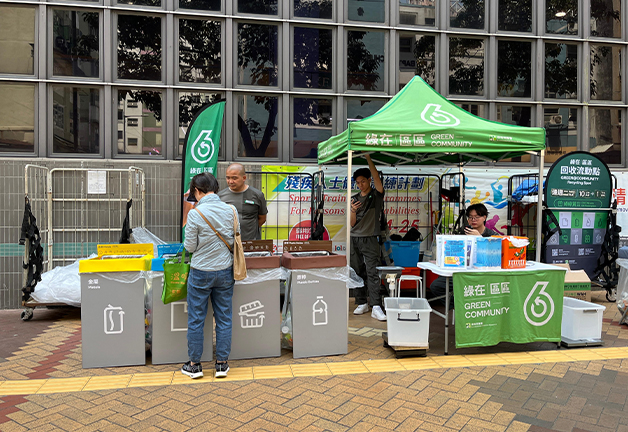

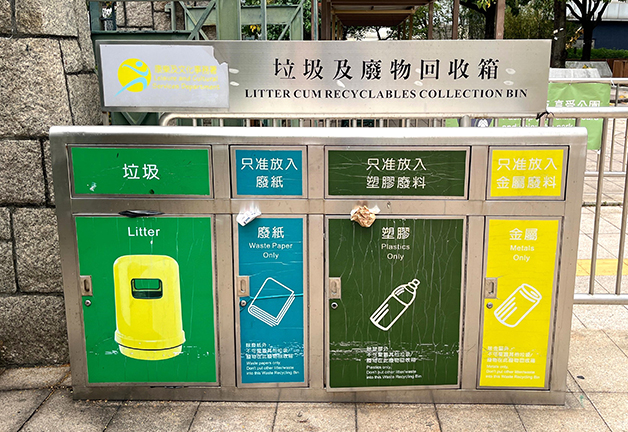



The Waste Reduction Framework Plan was introduced. Waste separation bins (commonly known as “three-colour recycling bins”) for collection of waste paper, aluminium cans and plastic bottles were placed at government buildings.
The Programme on Source Separation of Domestic Waste was launched to provide “three-colour recycling bins” to housing estates / residential buildings.
The Programme on Source Separation of Waste was extended to industrial and commercial buildings.
Then Environment Bureau announced a plan for creation of five pilot Community Green Stations (CGSs) to be run by non-governmental organisations.
Plan for one CGS in each of the 18 districts was announced in the 2014 Policy Address.
The Sha Tin Community Green Station - the first district green station - opened to the public.
The EPD took over the management of kerbside three-colour bins from the Food and Environmental Hygiene Department and changed their design.
GREEN$ Electronic Participation Incentive Scheme was introduced.
GREEN@COMMUNITY featuring “6” in the brand logo opened many Recycling Stores.
As GREEN@COMMUNITY developed, the EPD gradually removed kerbside recycling bins from urban areas. Around 1,100 recycling bins remained in public places.
The Environment Bureau announced the Waste Blueprint for Hong Kong 2035 on 8 February 2021. Setting out the vision of “Waste Reduction‧Resources Circulation‧Zero Landfill”, the blueprint outlines the government’s grand design for waste management up to 2035.

Per capita MSW disposal
Recovery rate
40-50%
~55%

Developing adequate waste-to-energy facilities to move away from landfills.
The Blueprint puts forward Six Major Areas of Action to achieve waste reduction, resources and energy recovery goals.
Economic incentive for waste reduction is premised on the principles of “polluter pays” and “sharing eco-responsibility”.

Municipal Solid Waste (MSW) charging was scheduled for implementation in 2024. In line with the “polluter pays” principle, all stakeholders were mandated to pay a levy on waste disposal.
Waste disposal levy is common in places adjacent to Hong Kong, such as Singapore, Japan, Korea, Taiwan. They have proven effective in reducing waste, which is a result of both waste reduction at source and increased recycling by individuals and companies to lower their waste disposal costs.
Having considered the outcome of the Demonstration Scheme for MSW, the government announced to defer MSW charging in response to public reservations in April 2024 and promised further research on how to enhance the scheme.
Suspension notwithstanding, waste charging has been proven effective in reducing waste in other regions. An enhanced MSW charging scheme shall be met with public support when it is relaunched, provided that comprehensive recycling facilities are already in place.

Producer responsibility scheme (PRS) was mentioned in the Waste Blueprint for Hong Kong 2035 as a key policy tool for waste reduction.
Premised on the principles of “polluter pays” and “shared eco-responsibility”, the PRS provides economic incentive to relevant stakeholders including manufacturers, importers, wholesalers, retailers and consumers to recycle. The more waste one produces, the more one pays.
Greater waste reduction relies on the combination of “economic incentive”, “polluter pays” and “shared eco-responsibility” principles to engage all stakeholders.
* Suppliers:Manufacturers and importers
# The upcoming scheme is yet to be implemented.
The 14th Five-Year Plan is the economic and social developmental strategy for years 2021 to 2025 announced by the State Council of China.
The Plan outlines the following areas of green transition on resources allocation and carbon emissions for the attainment of sustainable development and better protection of the eco-system:
1. Promote green development of industries and agriculture
2. Promote low-carbon consumption and emissions
3. Support development of green technologies
4. Expand green infrastructures (e.g. renewable energy facilities)
5. Develop resources circulation system (e.g. waste separation and water cycle)
6. Improve legal supervision (strengthen regulation, greener standards of accreditation)

Smart recycling bins have proliferated in many locations across China, with a total of 20,000 bins as of 2024, collectively collecting 2,000 tonnes of waste daily. Credits are deposited in electronic wallets when individuals dispose of garbage at these bins, which can be redeemed. These bins were installed by private companies to endorse the state’s green policies and promote green consumption, occasionally in collaboration with lifestyle brands.
Source: China Daily
